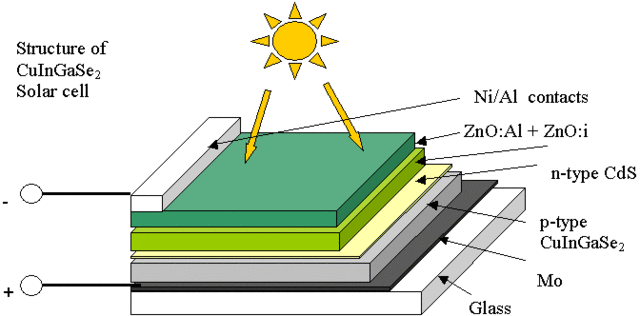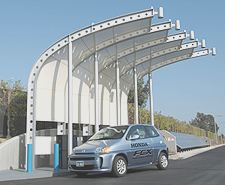|
HONDA - SOLAR CAR
|
|||||
|
HOME | BIOLOGY | BOOKS | FILMS | GEOGRAPHY | HISTORY | INDEX | INVESTORS | MUSIC | NEWS | SOLAR BOATS | SPORT |
|||||
|
One time
winner of the Darwin to Adelaide race and arguably, the most expensive
solar powered vehicle project to date. This Honda car was used very
successfully to advertise Honda road vehicles. This sums spent
developing this car would have built and equipped the Solar
Navigator
catamaran. Honda
- Darwin to Adelaide winner Entrants
in the cross Australia race, from Darwin to Adelaide, use solar panels to
power a lightweight car over 2,000 miles at speeds of up to 50 miles per
hour. Clearly, solar power can deliver enough
energy to drive a vehicle considerable distance given the right
conditions. Nikkei.
Honda Motor is entering the market for solar cells designed for use in
households and also plans to promote their use in vehicles, according to a
report in the Nihon Keizai Shimbun. Honda
is building a ¥10-billion (US$86.5-million) factory to begin mass
production in fiscal 2007 of solar cells made an inexpensive thin-membrane
non-silicon metal compound developed by Honda engineering. The Honda solar
panels, first announced in 2002, feature a light-absorbing layer formed by
a compound made of copper, indium, gallium and diselenium (CIGS).
Thin-film
solar cells based on CIGS (Cu(In,Ga)Se2) absorbers are among
the leading devices which are expected to lower the costs for photovoltaic
energy conversion. Other companies working with CIGS cells include Shell
Solar and Würth.
Early
Honda CIGS module prototypes had a maximum output of 112 W at dimensions
of 1,367 × 802 × 46 mm. Honda is working to improve the efficiency.
Honda’s
solar cells will likely sell for some 1.5 million yen each, 20%-30% less
than silicon-made cells, according to the report.
The
new plant will initially have an annual capacity to produce about 30
megawatts worth of solar cells, enough for 10,000 households a year.
Initially, the company aims to market them only in Japan. But it will
later sell them in overseas markets, eyeing mainly North America and
Europe, where demand is expected to surge in the future.
Honda
is also considering a scheme that would use solar cells to power a home
electrolysis unit for the production of hydrogen for vehicle refueling.
Honda’s current prototype home hydrogen energy
systems rely on natural gas reforming.
Honda
combined its CIGS solar cells with a Honda-developed compact electrolysis
unit that uses a new Ruthenium-based catalyst in a prototype at its
Torrance, California facility. The prototype solar-powered electrolysis unit produces
hydrogen at a rate of 2 normal cubic meters per hour (Nm3/hr).
A
SUSTAINABLE FUTURE
Never
mind the politics, people need a place to live, food
and energy. Imagine a world where there is abundant energy for
transport, the home and our factories, and that energy does not harm our
environment.
Imagine that the world economy
is stable and that the population
is under the threshold where the planet
can meet our needs. Isn't that a wonderful vision?
That
ideal may not be totally within our grasp. But we can at least strive
for clean
energy for living, which is technologically within sight.
RENEWABLE
ELECTRICITY Solar
power from
micro generation is now a growing industry as many Youtube videos are
demonstrating. As these conversions and new builds gain in popularity
electric vehicles will also gain favour, especially for households
generating excess energy,
which they could get better value from by using for transport.
Electricity used in this way might reduce transport costs
by up to 200%. So provide a higher quality of life with lesser
environmental damage. If
buying an EV,
it would make sense to have the latest future proof technology, such as battery
cartridge exchange built into the vehicle, for self servicing, or
exchanges at local stores or cooperatives. This technology exists but
has not yet been incorporated in production
vehicles. When
EVs become available with cartridge
refueling, it would make sense to have in place at least a few service
stations to cater for eventual demand. The technology would thus be
in place when it is needed. Such a move when it is implemented will
greatly reduce carbon
dioxide build up in the atmosphere and ease the transition from oil
based economies to abundant clean energy. THE
CHICKEN AND EGG SITUATION If
there were service forecourts to cater for battery cartridge exchange,
that might in turn persuade motor manufacturers to produce vehicles with
the system. This is a classic chicken
and egg situation. Who should do what first. Given
the scale of the problem, it might be prudent for every corporation
involved in the industry to at least investigate the potential that any
emerging technology might offer for the future on mankind,
which is after all the future of their company and eventual profits for
their shareholders. WSC
2011 - Panasonic
Solar Cola drinkers care about climate chaos ......
....... Pioneering research for the Planet
|
|||||
|
This
website
is Copyright © 1999 & 2012 Electrick Publications.
The bird |
|||||
|
AUTOMOTIVE | BLUEPLANET | ELECTRIC CARS | ELECTRIC CYCLES | SOLAR CARS |

